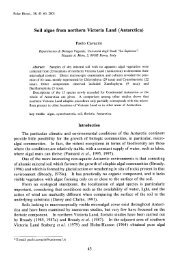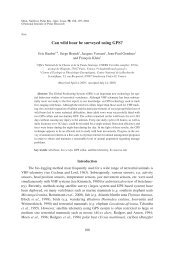ANTARCTIC TARDIGRADA 111. FILDES PENINSULA OF KING ...
ANTARCTIC TARDIGRADA 111. FILDES PENINSULA OF KING ...
ANTARCTIC TARDIGRADA 111. FILDES PENINSULA OF KING ...
You also want an ePaper? Increase the reach of your titles
YUMPU automatically turns print PDFs into web optimized ePapers that Google loves.
Fig. 7. Diphascon (D.) alpinum: a. Ventral<br />
view; b. mouth apparatus (lateral<br />
view); c and d. doubleclaws of legs 111<br />
and IV, respectively.<br />
K. UTSUGI and Y. OHYAMA<br />
Fig. 8. Diphascon (D.) higginsi: a. Left later-<br />
al view; b. mouth apparatus; c and d.<br />
doubleclaws of legs 111 and IV, respec-<br />
tively.<br />
Hexapodibius sp.<br />
(Fig. 9a-f)<br />
Body 420 to 607 pm in length. Eyespots present. Small conical papillae<br />
arranged in several transverse bands of cuticle. Number of papillae on a band 2-12,<br />
varying with band. Papillae developed dorso-laterally, but reaching to ventral side in<br />
some bands. Anterior part of mouth tube curved ventrally. Pharyngeal bulb round,<br />
with apophysis and three macroplacoid. Microplacoid absent. First and second<br />
macroplacoids short, rod-like (6 and 5 pm in length), third one longest (8 pn in 607<br />
pm specimen) and with a tiny constriction at posterior end. Internal and external<br />
claws developed on anterior three pairs of legs are the same shape. Primary branch<br />
long, secondary branch short, at obtuse angle with primary one. Fourth pair of legs<br />
very short; claws considerably vestigeal, short hook-like or absent.<br />
The present specimens were obtained from only one site (No. 8) close to the Chi-<br />
nese Great Wall Station.<br />
Remarks: Hexapodibius sp. has peculiar small conical papillae in the transverse<br />
bands on the dorsal to lateral cuticular body surface, whereas the other six congeneric<br />
species lack any papillae or projections on body surface. It is, therefore, possibly new<br />
species of this genus. But it is not described here, until the additional specimens will




